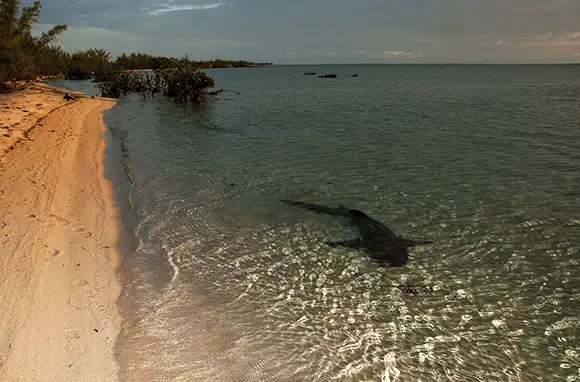
The luster of a beautiful beach—vivid blue water, cloudless skies, warm sand—belies the innate perils of the shore. Beaches are subject to the unpredictable, wild nature of our environment. They harbor hazardous plants and animals. They get polluted. They sustain dangerous wave conditions. We don’t want to scare you, but we do want you to be safe on your vacation. Here are 10 common dangers of which you should be aware before your next trip to the seashore.
Image Gallery
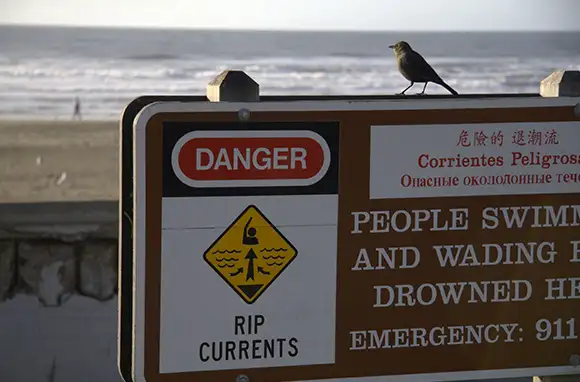
Rip Currents
Also known as riptides or undertow, rip currents are powerful channels of water near the shoreline that flow away from land. They're often difficult to spot, and to make matters worse, rip currents can race at dizzying, dangerous speeds of up to eight feet per second. According to the National Oceanic and Atmospheric Administration (NOAA), rip currents are the reason behind more than 80 percent of lifeguard rescues, and more than 100 people drown each year in the U.S. due to this serious oceanic hazard.
How to Stay Safe: First and foremost, never swim alone, and stick to swimming at shores with lifeguard supervision. Be especially careful when swimming close to piers and jetties, as riptides often form near these structures. If, heaven forbid, you find yourself caught in the pull of a riptide, don't fight it, and don't panic. A rip current won't pull you under. It'll pull you away from the shore, so you need to remove yourself from the current before you head toward land. Swim parallel to the coast to escape the current, then swim at an angle back to shore when you're free from the pull of the undertow. For more information, read the National Weather Service's guide to Rip Current Safety.

Rip Currents
Also known as riptides or undertow, rip currents are powerful channels of water near the shoreline that flow away from land. They're often difficult to spot, and to make matters worse, rip currents can race at dizzying, dangerous speeds of up to eight feet per second. According to the National Oceanic and Atmospheric Administration (NOAA), rip currents are the reason behind more than 80 percent of lifeguard rescues, and more than 100 people drown each year in the U.S. due to this serious oceanic hazard.
How to Stay Safe: First and foremost, never swim alone, and stick to swimming at shores with lifeguard supervision. Be especially careful when swimming close to piers and jetties, as riptides often form near these structures. If, heaven forbid, you find yourself caught in the pull of a riptide, don't fight it, and don't panic. A rip current won't pull you under. It'll pull you away from the shore, so you need to remove yourself from the current before you head toward land. Swim parallel to the coast to escape the current, then swim at an angle back to shore when you're free from the pull of the undertow. For more information, read the National Weather Service's guide to Rip Current Safety.

Sharks
The entertainment industry fuels our fear of sharks. But are the frightening fish a legitimate threat? According to some reports, there's been an increase in shark attacks in recent years. Paul Matusheski, executive producer of "Sharkpocalypse," told Fox News, "Last year actually was the highest [number of shark attacks] in 10 years in the United States." Shark attacks on the rise—it's a scary thought. Still, according to the Florida Museum of Natural History, your chances of dying from a shark attack are less than one in three million. Take that as you will.
How to Stay Safe: There are many tips and tricks for avoiding contact with sharks: Don't swim at night, don't thrash around in the water, don't stray too far from shore, don't swim with horses or dogs, don't go in the ocean if you're bleeding. Find more strategies for staying safe from shark bites on Oceana.org.
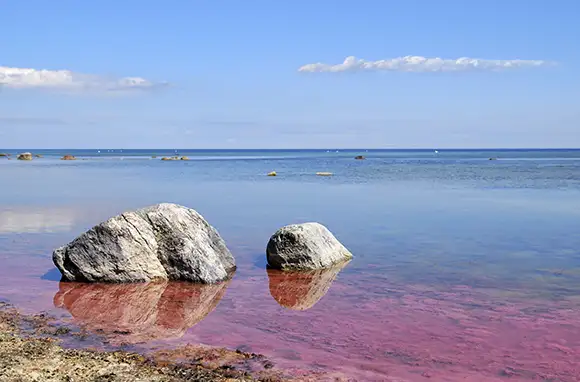
Harmful Algal Blooms
Widespread blooms of algae, sometimes called red tides, can be extremely dangerous to people and animals. Algae aren't always harmful. But the toxins that are sometimes produced by naturally occurring, wildly flourishing colonies of microscopic algae can cause diarrhea, vomiting, abdominal cramping, and even death. Harmful algal blooms (HABs) occur in lakes and oceans all over the United States and around the world, and this serious threat to human health appears to be on the rise. According to the NOAA, HABs are becoming more common in waters in the U.S.
How to Stay Safe: Although HABs are sometimes referred to as red tides, they're not always red. Harmful algae blooms in water can appear black, white, green, blue-green, brown, purple, or red, and they can have the texture of cottage cheese, thick soup, a crust, or a film in the water. If you see this kind of thing, stay out of the sea, and if you believe you've been exposed to a HAB, see a healthcare professional. You should also report a suspected HAB to local officials. Check for HAB warnings regarding U.S. waters on the NOAA website.

Falling Coconuts
We're not kidding. Falling coconuts are a real threat. Think about it: A nine-pound ball of coconut meat dropping 100 feet to the ground can cause serious injury to a beachgoer. And it has. According to a report from the National Center for Biotechnology Information (NCBI), the blow of a tumbling coconut can exceed one metric ton. We don't have definitive statistics on the deadliness of coconuts, but there are documented cases of beachgoers suffering fractured sculls and concussions from the falling fruits.
How to Stay Safe: It's simple. Don't park your towel in close proximity to palm trees, especially on windy beaches.
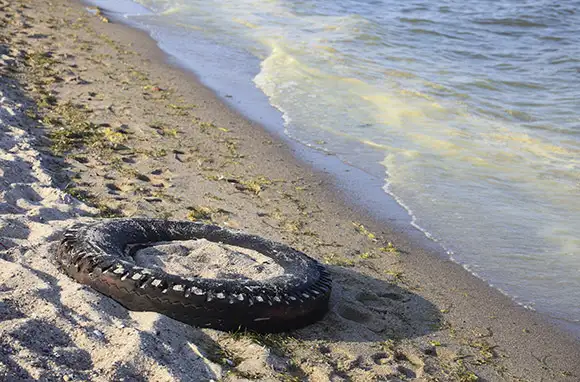
Unclean Water
Unfortunately, beach pollution is quite common. The Natural Resources Defense Council (NRDC) reports that every coastal state in the U.S. has a polluted beach. Water contaminated by sewage, storm-water pollution, and other hazardous substances can make beachgoers very sick. Bacteria and viruses in foul water can cause a range of illnesses, from infections to hepatitis to stomach flu.
How to Stay Safe: Although beaches in the United Stated are monitored by health and environmental officials, not all beaches are regularly tested for pollution. So, although beachgoers can check for cleanliness ratings on sites such as the NRDC, polluted water doesn't always come with a warning—especially overseas. If you start to feel sick after swimming, clean your skin with soap and water and use mouthwash. Of course, see a doctor if necessary, and tell him or her that you think you've been exposed to polluted water. The NRDC recommends that swimmers protect themselves by "avoiding swimming at beaches with nearby discharge pipes or at urban beaches after a heavy rainfall, staying out of murky or foul-smelling water, staying out of the water when they have an open wound or infection, and swimming without putting their heads under water."
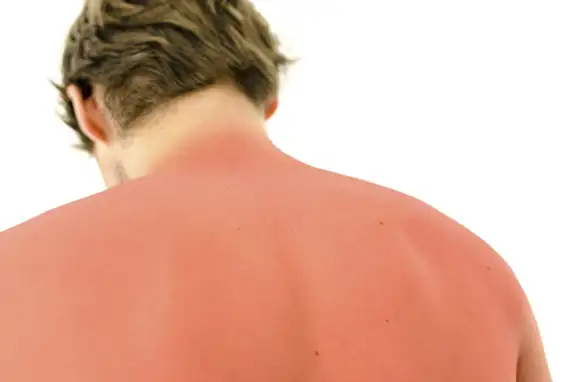
Sunburn
It's safe to say that skin damage from ultraviolet (UV) radiation is the most common hazard at the beach. Destinations near the equator are particularly perilous for beachgoers, as low-latitude destinations receive stronger, more direct rays of sunlight. The ocean water reflecting the light of the sun can increase the severity of UV radiation as well. Pay attention to the clock: In the continental U.S., the sun's rays are most harmful between 10 a.m. and 4 p.m., especially in late spring and early summer.
How to Stay Safe: Sunscreen, shade, protective clothing, and more sunscreen. The CDC recommends using a sunscreen with a minimum SPF of 15 and advises that tightly woven fabric offers better protection than looser knits.
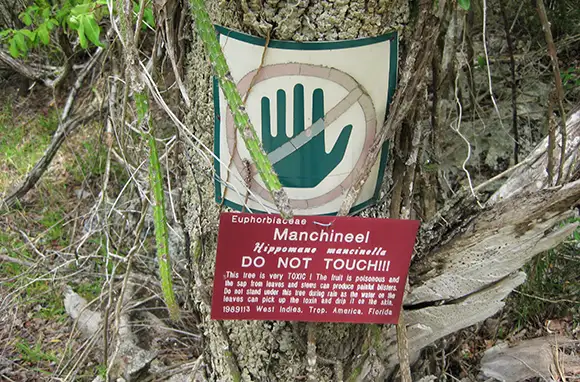
Poisonous Manchineel Trees
It's never a good idea to eat strange fruit that you find on the ground. Case in point: The small green apples you spot on that Caribbean beach may be the fruit of the manchineel tree, also known as the beach apple or (cue the ominous music) death apple. Whatever you do, don't eat the death apple. The poisonous produce can cause blisters in the mouth and throat, and the tree's leaves and sap are toxic too. So stay far away from this plant, which looks like an apple tree with shiny green leaves and is found on beaches in the Caribbean and Central America.
How to Stay Safe: On some beaches, manchineel trees are marked with a warning sign or a red "X." Heed the warnings: Stay far away from this tree, and don't even use it for shade. (The dripping poisonous sap could get you.) Sign or no sign, it's wise never to eat from or touch strange plants on beaches.
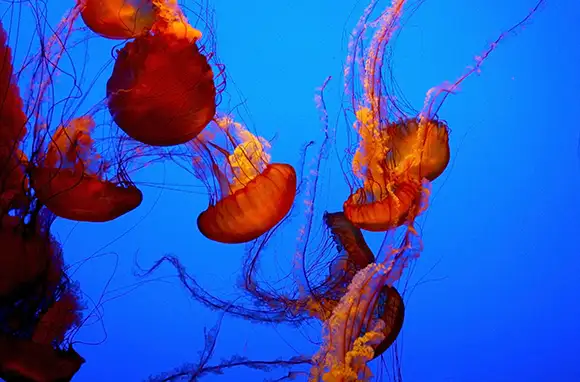
Jellyfish
Some jellyfish are harmless. Others are tentacle-trailing monsters capable of ending human life. Lethal box jellyfish, which are predominately found in the ocean waters of Northern Australia and throughout the Indo-Pacific, cause, according to some sources, more than 100 deaths annually. Sea nettles, the most common species of jellyfish on the northeastern coast of the United States, aren't as scary as the man-sized, venomous box jellyfish, but the stings of these umbrella-shaped creatures can cause rashes and painful muscle cramps. Other harmful jellyfish species include the Portuguese man-of-war, which lives in warm ocean waters all over the world, and the lion's mane jellyfish, found in colder regions of the Pacific and Atlantic oceans.
How to Stay Safe: Covering skin with a wet suit or a rash guard in waters where jellyfish proliferate is a smart move. Furthermore, know when to stay out of the water by checking jellyfish reports and advisories via local health and safety officials. The government of Australia's Northern Territory, for example, warns swimmers to remain on land during "Stinger Season," from October through May.
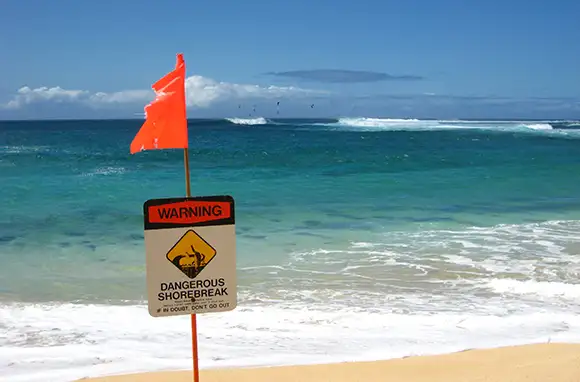
Shore Breaks
When a wave breaks directly on the sand or in shallow water, it can pitch swimmers or surfers onto the ground with great force; this is called a shore break. It's a legitimate and often underestimated danger at the beach. According to 22-year Ocean City Beach Patrol veteran Sgt. Ed Fisher, "Shore break occurs when waves, rather than breaking on the sandbar, continue to build and crash with full force on the shore with little or no water depth. When unsuspecting victims find themselves on a breaking wave and they are being thrown into shallow water, they have set themselves up for a tragedy." Unpredictable shore breaks can cause neck and spinal injuries to beachgoers, or even death.
How to Stay Safe: During shore break conditions, ocean water can appear deeper than it actually is. Never dive headfirst into water unless you are absolutely sure of its depth. Ask a lifeguard about wave conditions, and stay aware of dangerous waves.
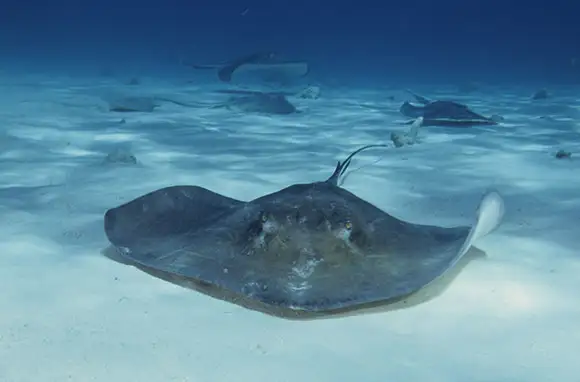
Stingrays
Forget sharks. If any sea-dwelling animal brings chills to a beachgoer's spine, it should be the stingray. It's generally safe to swim alongside these cartilaginous creatures—but the real danger lies at your feet. Rays often bury themselves in sand in shallow coastal waters, and when a person steps on a concealed, sand-covered ray, bad things happen. Rays' stings can be extremely painful. According to some sources, most stings take place at ankle level because rays have a tendency to whip up their barbed tails and give biting stings when treaded upon.
How to Stay Safe: Do the stingray shuffle. When walking in shallow waters, shift your feet back and forth in lieu of taking steps; this helps to scare off nearby rays hiding in the sand.
More From Smartertravel:
We hand-pick everything we recommend and select items through testing and reviews. Some products are sent to us free of charge with no incentive to offer a favorable review. We offer our unbiased opinions and do not accept compensation to review products. All items are in stock and prices are accurate at the time of publication. If you buy something through our links, we may earn a commission.
Related
Top Fares From
Today's Top Travel Deals
Brought to you by ShermansTravel
Greece: 9-Night Vacation, Incl. Meteora &...
Exoticca
 vacation
$2149+
vacation
$2149+
London to Reykjavik: Luxe, 10-Night Northern...
Regent Seven Seas Cruises
 cruise
$8175+
cruise
$8175+
Ohio: Daily Car Rentals from Cincinnati
85OFF.com
 Car Rental
$19+
Car Rental
$19+



